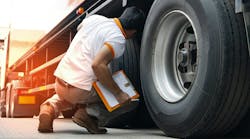When you treat your body like an amusement park, don’t be surprised when the rides start breaking down. I’ve been saying that for years to cope with how, as I get older, little aches and pains have reached the point where I hurt myself when I sleep. For example, my knee felt fine last night; when I woke up this morning, it didn’t. I have no idea what happened, but it wasn’t a problem when I went to bed. Now it is.
At this point, I just have to accept that the hard miles of life are taking their toll on the chassis. When aches and pains don’t improve after a few days, it’s time to seek help from a medical professional. If I’m honest with them about the location, severity, and frequency of the pain, then I have a better chance of making a full recovery.
Pre-trip and post-trip tire and wheel inspections are like human self-examinations that are a precursor to a physical or doctor’s visit. Truck drivers are not wheel-end experts, nor are they expected to be. However, to receive a commercial driver’s license, there is a certain degree of training dedicated to inspecting equipment for conditions that may negatively impact the vehicle’s safe operation.
In some cases, a condition is a violation of safety standards established by the Department of Transportation that results in a citation. In others, it’s an out-of-service condition that must be corrected before the vehicle can return to service, according to the Commercial Vehicle Safety Alliance.
See also: Rohlwing: Fueling infrastructure funding foes
A DOT violation or OOSC does not generally happen overnight. Some conditions like cuts, missing rubber, or cracks occur during operation. Still, things like insufficient tread depth and wheel cracks may take some time before they reach the point where a vehicle enforcement official is likely to notice them. A fleet’s first line of defense is proper pre-trip and post-trip inspections since the driver is the only person who knows the vehicle’s condition at the beginning and end of the day.
Suppose the driver sees a tire or wheel condition that may violate DOT regulations or CVSA safety standards. In that case, they are responsible for reporting it so it can be corrected. If nothing is noted, then DOT, CVSA, and the carrier assume the vehicle is safe to operate.
When a problem is present, and the vehicle is referred to a commercial tire and wheel expert, then the expectation is that the issue will be corrected. I’ve been involved in several lawsuits lately where the fleet requested service on one wheel position, and then shortly thereafter, a tire or wheel in a different position failed and caused an accident. The plaintiffs alleged that it was the service provider's duty to provide a complete tire and wheel inspection on the entire vehicle regardless of the service requested. That’s like me suing my orthopedic physician because they didn’t diagnose an ulcer when I got my knee examined.
We live in a society where someone has to be at fault when something bad happens. Driver pre-trip and post-trip inspections aim to identify potential violations before they result in a roadside failure or accident. Thumping a tire is not an inflation pressure check. Suppose there are cracks or cuts in the rubber. In that case, the driver must identify them during the inspection and then refer the vehicle to a professional for further examination to determine if the tires can be operated safely.
If DOT or CVSA violations are not identified and result in an accident, it will fall back on the failure of the driver to fulfill their obligation. Likewise, if the driver identifies a problem and the carrier or vehicle owner refuses to have it corrected, fault will be easy to determine in the eyes of a jury.
The reasonable expectations that form the basis of every standard of care lawsuit are subjective. In the recent cases where I testified on behalf of the defense, it was determined that it was not reasonable to expect a service provider to identify a potential problem on a tire/wheel position they were not asked to service.
Drivers are responsible for inspecting their vehicles and reporting any defects. When that inspection is incomplete or nonexistent, the vehicle's safe operation comes into question.



